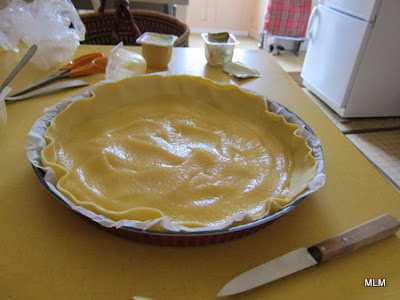 "Un repas sans fromage comme un journée sans soleil."
"Un repas sans fromage comme un journée sans soleil." – French proverb
(Translation – Any meal without cheese is like a day without the sun.)
One of the things I enjoy most about our trips to France is the Cheese. Way back in 2000, on my first trip to France with CL, I decided that I wanted to try all 365 cheese in France. Since that early declaration, I've scaled back ...

An essential reference is the DK book,
French Cheeses : The Visual Guide to more than 250 Cheeses from every region of France by Kazuko Masui and Tomoko Yamada. [As an aside, I have to chuckle every time I see the authors' names. My sister married a man from Japan who does not have such an appreciation for cheese.] If you don't want to purchase a copy, try your
local public library. It's well worth a look with color photos and commentary.
On each trip to France, I take notes on the cheeses we eat, which ones we like, what year we had them, etc. I note all this in my copy of the French Cheeses book (above). After 10 years of tracking our cheese habits, we mostly stick to the same list of 40 (or so) cheeses. This is partially limited by the fact that we tend to visit the same areas each time (That's where the family and friends are, so that's where we go). We also know what we like now, and tend to want to have the "good ones" again while we can get them in country. Many cheeses are regional, so if you don't get to a particular region, you may not be able to get a particular cheese easily.
If you're not serious enough to get the book, try the
Wikipedia listing of French Cheeses. It's not complete, but it's a good starting point.
[Add Photo of Cheese Market]
The cheese counters/aisles in French grocery stores are magnificent! You've never seen anything like it in the US. [By the way, they consider most of our American cheeses as "plastique" meaning tasteless and dead because they are always wrapped in plastic and not allowed to breathe. I'm trying to share some of the artisinal cheeses made in the US--and we have some good ones, too!]

After a typical French meal, a plate of cheese is presented (before dessert). Under ideal conditions, this plate is allowed to warm to room temperature as that brings out the flavors better. The cheeses are usually eaten with a good French bread (another staple). Some cheeses (like
Roquefort) are so strong, they are best eaten with wine. (I don't consider myself a wine drinker, but even I can tell that Roquefort is tempered by a good red wine. Our French family and friends knew I was serious when I ate and enjoyed Roquefort, a serious blue cheese.
Here are some of the cheese plates we encountered on this trip.
Our favorites are starred ***.

Starting at 12:00 and working "around the clock," these cheeses are :
Chaource *
St. Felicien du Dauphine
Roqurfort *
(Walnut cheese of unknown provenance)
Brique de Chevre du Forez
Comte * (center)

At a family reunion we were invited to attend, a large wheel of Brie de Meaux was presented on a straw mat. This one was made from un-pasturized milk. A second wheel of Brie was made from pasturized milk, which had a much milder taste.
Here's what it looks like "plated."

In France, salad comes at the end of a meal. In this case, it was presented along with the cheese. An elder in the family walked by with his plate, and he had such a big piece of this cheese, I thought it must have been a piece of white cake ... Nope! It was cheese!

In the evening, we had a cheese tart made with
Maroilles cheese. This cheese is so strong that you can't eat it cold. It is tamed with heat, and so they serve it on a tart.

Starting at the the top (or 1:00, in this case) :
Gaperon *
Cantal *
Fourme D'AmbertChevre (a local goat cheese)
St. NectaireBleu D'Auvergne

The Gaperon was a new cheese for us on this trip--and a most pleasant surprise! It is very flavorful, but fierce (even, severe) looking cheese. It's not for the faint-of-heart! Unfortunately, it is not a well-respected cheese as it is low-fat and made from the whey left over from another process. Gaperon has a garlic and cracked pepper flavor that kept me going back for more--until I could identify the flavors (The reference book was back in our room, so I couldn't check it at the table.)
What about the rind, you ask? Some of the moldy rinds are edible; some are not (For instance, some rinds might be too dry or hard to chew). Usually it's a personal preference as to whether or not you eat the rind. It is essential part of making many cheeses.

Starting at 1:00 :
CantalRoquefort (bleu)
Petitte Billi (fresh goat cheese) *
Brebis Pays Basque *
Other Cheeses this trip :

Perail (by Lou Perac) *
CamambertBoursin *
There are many other favorites that we didn't get to try this year, but I'll stop here with my cheese reverie. Bon Apetit!





































